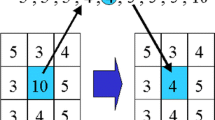Abstract
Images captured by cameras are sometimes contaminated either during acquisition or transmission. Therefore, a preprocessing step is required which reduces noise from images. In this paper, a novel and efficient edge preserving universal noise removal algorithm is proposed which exploits both the local and global characteristics of the neighboring non-corrupted pixels. In the proposed algorithm, corrupted pixels are detected by robust outlying ratio (ROR) and replaced with the weighted sum (local characteristics) of the neighboring non-corrupted pixels in 3 × 3 window and these weights are obtained by solving the kernel ridge regression (KRR) which uses the global mean and covariance (global characteristics). Extensive experimental results demonstrate that our algorithm has better noise removal capability in terms of both objective and subjective evaluation as compared to existing denoising algorithms.




Similar content being viewed by others
References
Abreu E, Mitra SK, Arakawa K (1996) A new and efficient approach for the removal of impulse noise from highly corrupted images. IEEE Trans Image Process 5(6):1012–1025
Akkoul S, Ledee R, Lecongee R, Harba R (2010) A new adaptive switching median filter. IEEE Signal Process Lett 17(6):587–590
Akkoul S, Ledee R, Lecongee R, Vilcahuaman L (2008) Comparison of image restoration methods for bioluminescence imaging. ICISP 5099:163–172
Buades A, Coll B, Morel JM (2005) A non-local algorithm for image denoising. Int Conf Comput Vis Pattern Recognit 60–65
Chen T, Wu HR (2001) Adaptive impulse detection using center -weighted median filters. IEEE Signal Process Lett 8(1):1–3
Chen B-H, Tseng Y-S, Yi J-L (2020) Gaussian-Adaptive Bilateral Filter. IEEE Signal Process Lett 1670–1674
Crnojevic V, Senk V, Trpovski Z (2004) Advanced impulse detection based on pixel-wise MAD. IEEE Signal Process Lett 11(4):589–592
Dong Y, Chan RH, Xu S (2007) A detection statistics for random valued impulse noise. IEEE Trans Image Process 16(4):1112–1120
Dong YQ, Xu SF (2007) A new directional weighted median filter for removal of random valued impulse noise. IEEE Signal Process Lett 14(3)193–196
Garnett R, Huegerich T, Chui C, He WJ (2005) A universal noise removal algorithm with an impulse detector. IEEE Trans Image Process 12(11):1747–1754
Gonzales RC, Woods RE (2010) Digital Image Processing. 2nd ed., Prentice-Hall 613–651
Hsing LC, Shiuan TJ, Te CC (2010) Switching bilateral filter with a texture/ noise detector for universal noise detector. IEEE Trans Image Process 19(9):2307–2320
Katkovnic V, Astola J (2010) From local kernel to non-local multiple-model image denoising. Int J Vis Comput 86(1):1–32
Lin Y, Liu W, Cai X, Chen W, Li L, Lan C (2020) A CNN-based Quality Model for Image Interpolation. Cross Strait Radio Sci Wirel Technol Conf (CSRSWTC). https://doi.org/10.1109/CSRSWTC50769.2020.9372617
Liu X, Zhou D, Gao W, Sun H (2011) Image interpolation via regularized local linear regression. IEEE Trans Image Process 20(12):3455–3469
Luo W (2005) A new efficient impulse detection algorithm for the removal of impulse noise. IEICE Trans Fundam Elecron Commun Comput E88-A(10):2579–2586
Nair P, Gavaskar RG, Chaudhury KN (2020) Compressive Adaptive Bilateral Filtering. IEEE Int Conf Acoust Speech Signal Process (ICASSP). https://doi.org/10.1109/ICASSP40776.2020.9053275
Sun T, Neuvo Y (1994) Detail-preserving median based filters in image processing. Pattern Recognit Lett 15:(4)341–347
Thaipanich T, Oh BT, Wu PH, Xu D, Kuo CC (2010) Improved image denoising with adaptive nonlocal means (ANL-Means) Algorithm. IEEE Trans Consum Electron 56(4):2623–2630
Toh K, Isa N (2010) Cluster based adaptive fuzzy switching median filter for universal impulse noise reduction. IEEE Trans Consum Electron 56(4):2560–2568
Tomasi C, Manduchi R (1998) Bilateral filtering for color and gray images. IEEE Int Conf Vis Comp 839–846
Xiong B, Yin Z (2012) A universal denoising framework with a new impulse detector and non-local means. IEEE Trans Image Process 21(4):1663–1675
Yu H, Zhao L, Wang H (2011) An Efficient Edge-based Bilateral Filter for Restoring Real Noisy Image. IEEE Trans Consum Electron 57(2):682–686
Zheng J, Song W, Wu Y, Liu F (2020) Image interpolation with adaptive k-nearest neighbours search and random non-linear regression. IET Image Process 14(8):1539–1548
Author information
Authors and Affiliations
Corresponding author
Additional information
Publisher's Note
Springer Nature remains neutral with regard to jurisdictional claims in published maps and institutional affiliations.
Appendix
Appendix
ROR | robust outlying ratio |
KRR | kernel ridge regression |
RVIN | Random valued impulse noise |
SPN | salt and pepper noise |
SMF | Standard median filter |
ACWF | adaptive center weighted median filter |
PWMAD | pixel-wise median absolute deviation |
CAFSM | cluster based adaptive fuzzy switching median |
ROLD-EPR | rank-ordered logarithmic difference edge preserving |
GABF | Gaussian-adaptive bilateral filter |
CNN | Convolutional Neural Network |
SVD | singular value decomposition |
ROAD | rank-ordered absolute difference |
Rights and permissions
About this article
Cite this article
Khan, S., Singh, Y.V. & Rai, A.K. An efficient edge preserving universal noise removal algorithm using kernel ridge regression. Multimed Tools Appl 81, 19863–19877 (2022). https://doi.org/10.1007/s11042-021-11274-4
Received:
Revised:
Accepted:
Published:
Issue Date:
DOI: https://doi.org/10.1007/s11042-021-11274-4




